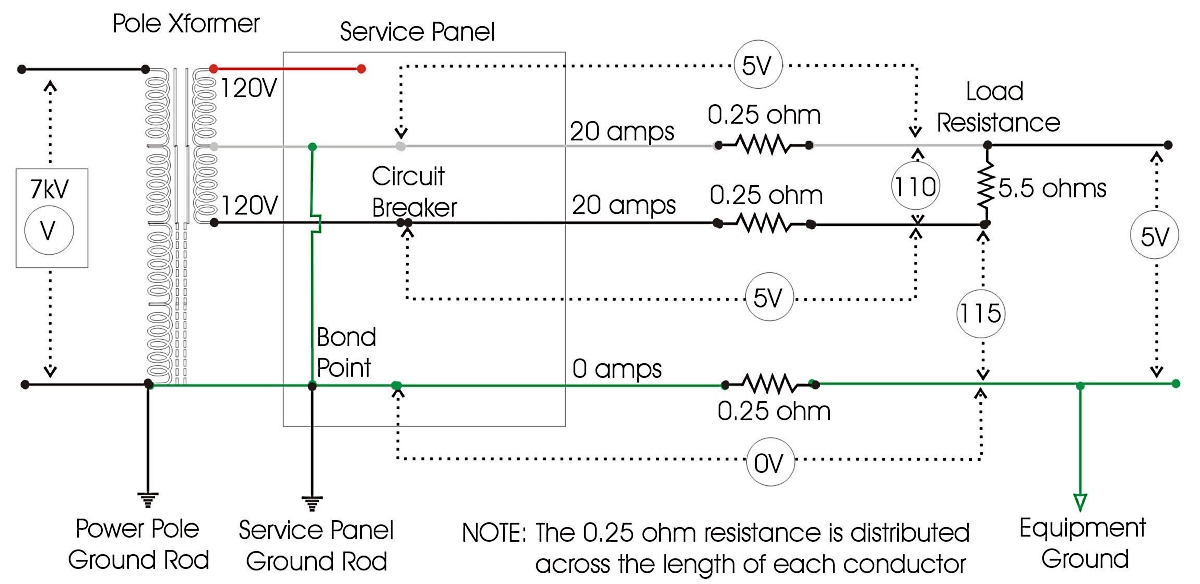We recently came across this interesting and highly instructive thread on the AC Power and Grounding forum in the Live Audio Board (LAB) on ProSoundWeb, and present it here with a light copy edit.
Question posted by Bill: We recently had a touring Christian band (that you may have heard of) play at our church. The rider called for 2 x 100-amp connections, 120-volt, 3-phase. Our electrical contractor tied their tails into panels.
The band’s tech lead was reluctant to connect the tails to the PA distro – he measured 2 volts between neutral and ground. They connected after a discussion with our electrician and the show went with no issues.
Is 2 volts a concern that we need to resolve?
Reply by Mike: In any subpanel with a load on it, there will nearly always be 1 or 2 volts between the ground and neutral. That’s because the ground and neutral should not be bonded at the subpanel, only at the incoming service panel. So if you have 4 volts drop on that panel due to a heavy load, then typically 2 of those volts are on the line conductor, and the other 2 volts are the drop on the neutral conductor. If you measure between the neutral and the ground on that subpanel you’ll come up with 2 volts.
I get worried when I measure exactly 0 volts between neutral and ground on a subpanel because that suggests a secondary neutral-ground bond on the subpanel. That 0 volts is because you’ve now contaminated the ground with the voltage fluctuations on the neutral due to load variations. And that’s what causes ground loop hums.
Reply by Stephen: A bit of a swerve, but relevant (I think?): Can you even get a UL listing for equipment that has neutral connected to a chassis? Wouldn’t that create a secondary ground/neutral bond? I know chassis tied to neutral used to be standard fare. If there’s no connection the voltage difference is irrelevant.
Reply by Mike: That’s correct. However, while there’s no hard connection between the neutral and ground in any modern gear, there often is some sort of capacitor-based RF circuit between the neutral and ground to reduce RF generation. I believe that this high-frequency path can allow transient currents in the line and neutral to be transferred into the grounding system.
I drew Figure 1 a while ago to help me better understand the various voltage drops in a typical power distro system, and what certain measurements could possibly mean. I try to go into every voltage or current test situation with at least a guess of what measurement to expect. If the voltage measured doesn’t line up with my expectations, then there’s a hint as to what’s wrong.

For instance, as you load a typical home branch circuit with more current draw and approach 20 amps, you’ll likely come close to a 5 percent voltage drop. So 120 volts drops by 6 volts to 114 volts. But only 3 of those volts are on the hot/line conductor. The neutral conductor does an equal and opposite “rise” in voltage, so it will create a voltage difference if you measure between it and the grounding conductor.
This basic knowledge is essential to troubleshooting any grounding system. That’s because all wires have resistance. And resistance always results in a voltage drop if there’s any current draw. It’s a fundamental law of electricity.
Reply by Bill: Thanks Mike. There was no load on that sub panel but there were other loads on that service. So the small potential he measured in the sub panel is to be expected. A higher voltage could be a red flag requiring investigation.
Reply by Mike: Exactly. Most electricians and even electrical engineers often don’t understand this basic principal. But now you know…
Reply by Jonathan: A couple of things I noted in this discussion:
1) The touring engineer actually metered the power before plugging in.
2) The touring engineer didn’t fully understand the readings that were observed.
So, to the first point, it appears that electrical safety education may be getting out there. To the second point, it appears that more education is needed. Maybe that’s covered in “Entertainment Electrics 102.”
You can follow this ongoing discussion on the AC Power and Grounding section of the ProSoundWeb forums here.














